Circuit de Barcelona-Catalunya | Análisis [ESP-ENG]
A mediados de la temporada 2020 de la Fórmula 1 empezamos en este blog a realizar distintos análisis de los circuitos que iban siendo visitados por la máxima categoría. Los primeros 3 circuitos de la temporada 2021 ya fueron analizados hace unos meses en el 2020. Esta vez comparto un análisis del Circuit de Catalunya-Barcelona, previo al fin de semana de Gran Premio.
In the middle of the 2020 season, I started to make analyses of the circuits that were being run during the season. The first 3 circuits of the 2021 season were already analyzed a few months ago in 2020. This time I share an analysis of the Circuit de Catalunya-Barcelona, prior to the Grand Prix weekend.

Mutari 10:51, 21 September 2007 (UTC), Public domain, via Wikimedia Commons
Liberty Media, Public domain, via Wikimedia Commons
Este es un trazado muy conocido por la Fórmula 1 ya que no solo se celebran las carreras cada año sino que suele ser sede de los entrenamientos de pretemporada alrededor de 1 mes antes de la primera carrera. Recordamos también que fue el circuito en donde el venezolano Pastor Maldonado ganó la carrera del año 2012 frente a Fernando Alonso y Kimi Raikkönen.
This is a very well known track for Formula 1, since not only the races are held here every year, but it is usually the venue for pre-season training, about 1 month before the first race. We also remember that it was the circuit where the Venezuelan Pastor Maldonado won the 2012 race against Fernando Alonso and Kimi Raikkönen.
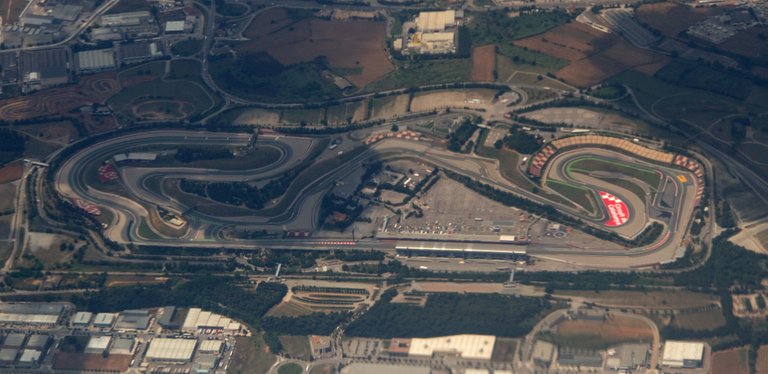
El circuito está ubicado en la comunidad autónoma de Cataluña, España, cerca de la ciudad de Barcelona, por ello el nombre del circuito. Sin embargo, también se le conoce como Circuito de Montmeló, debido al nombre de la localidad. Es sede del Gran Premio de España desde 1991, aunque ya otros circuitos de dicho país lo fueron anteriormente.
The circuit is located in the autonomous community of Catalunya, Spain, near the city of Barcelona, hence the name of the circuit. However, it is also known as Circuit of Montmeló, due to the name of the town. It has hosted the Spanish Grand Prix since 1991, although other circuits in Spain have hosted the Grand Prix before.
Trazado original
Original layout
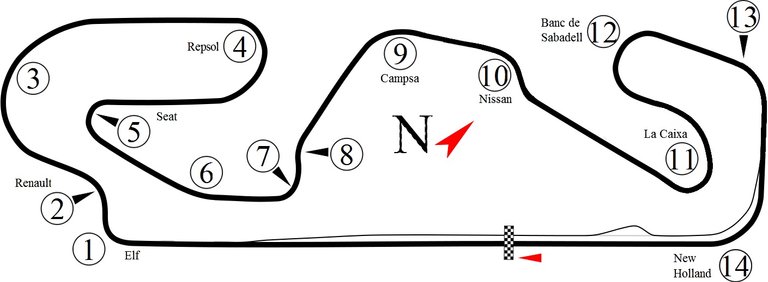
En 1991 se dio la primera carrera de Fórmula 1 en este circuito. El trazado original, tal como se ve en la imagen de arriba, era ligeramente distinto al del presente. Las curvas de la 1 hasta la 8, así como las 12 y 14 se conservan sin cambios hasta el día de hoy. El trazado original presenta marcadas características de un circuito clásico. Todas las curvas son redondeadas, incluso las que prosiguen a largas rectas. Existen cambios de elevación importantes, aunque no tan marcados como en otros circuitos clásicos, destacando el de la curva 7 a la 9.
Te recomiendo visitar un post anterior que escribí: Fórmula 1: ¿Qué caracteriza a los circuitos de leyenda?
In 1991 the first Formula 1 race was held at this circuit. The original layout, as shown in the picture, was slightly different from today. Turns 1 through 8, as well as turns 12 and 14 remain unchanged to this day. The original layout has marked characteristics of a classic circuit. All corners are rounded, even those that follow long straights. There are important elevation changes, although not as marked as in other classic circuits, highlighting the one from turn 7 to 9.
I recommend you to visit a previous post I wrote: Formula 1: What characterizes the legendary circuits?
Trazado contemporáneo
Contemporary layout
En 1995 se elimina la curva 10, por lo que se crea la larga recta entre las curvas 9 y la nueva curva N°10. Esto hace que los autos lleguen con mayor velocidad a la curva 10, algo a tener en cuenta para más adelante. Recordemos que la Fórmula 1 había sufrido las muertes de Senna y Ratzemberger en 1994, y el incremento de la velocidad de los autos hacía a la categoría cada vez más peligrosa.
In 1995, turn 10 is eliminated, so the long straight between turns 9 and the new turn N°10 is created. This makes the cars reach turn 10 with higher speed, something to be taken into account for later on. Let's remember that Formula 1 had suffered the deaths of Senna and Ratzemberger in 1994, and the increased speed of the cars made the category more dangerous.
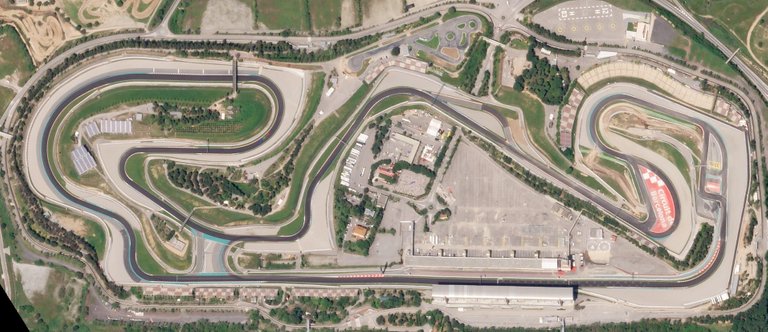
La ahora curva 10 no fue diseñada para esta nueva recta, ahora más larga. La curva 10 poseía una escapatoria muy corta (distancia hasta la barrera de neumáticos). Esta fue una de las razones para modificar esta zona en el año 2004 y crear una curva cerrada en forma de "V" que llevaría a los autos a frenar a fondo para reducir la velocidad y dejar más espacio entre la curva y la barrera de neumáticos. Esto se ve en la imagen de arriba, en la zona con suelo pintado de rojo.
También se introdujo en 2007 una modificación a la penúltima curva, introduciendo una chicane para así reducir la velocidad de los autos en esa zona por motivos de seguridad.
Esta última modificación se dio en específico para la Fórmula 1 y otras categorías, pero la curva 10, muy redondeada y rápida, se seguía utilizando en el motociclismo. En el año 2016, el piloto español de motociclismo Luis Salom fallece tras un accidente en la curva 13. Estas circunstancias harían que la Moto GP y la Fórmula 1 se pusieran de acuerdo para modificar la curva 10, tal como veremos más adelante.
The new turn 10 was not made for this new straight. It had a very short run-off (distance to the tire barrier). This was one of the reasons to modify this area in 2004 and create a closed "V" shaped curve that would lead the cars to brake hard to reduce speed and leave more space between the curve and the tire barrier. This can be seen in the image above, in the area with the red painted floor.
A modification was also introduced in 2007 to the penultimate corner, introducing a chicane to reduce the speed of the cars in that area for safety reasons.
This last modification was given specifically for Formula 1 and other categories, but the rounded turn 10 was still used in motorcycling. In 2016, Spanish motorcycle racer Luis Salom died after an accident at turn 13. These circumstances would make Moto GP and Formula 1 agree to modify turn 10, as we will see below.
Trazado 2021
2021 layout
Uno de los más aspectos más distintivos del trazado contemporáneo es lo trabado del último sector. El circuito original consistía en un trazado redondeado y continuo, pero en 2020 teníamos una curva 10 muy pronunciada y lenta, y un conjunto de curvas de 90° grados entre las últimas. Sim embargo, esto cambió un poco para el año 2021.
One of the most distinctive aspects of the contemporary layout was the tightness of the last sector. The original circuit consisted of a rounded and continuous layout, but in 2020 we had a very sharp and slow turn 10, and a set of 90° degree turns between the last few corners. However, this changed a bit for 2021.
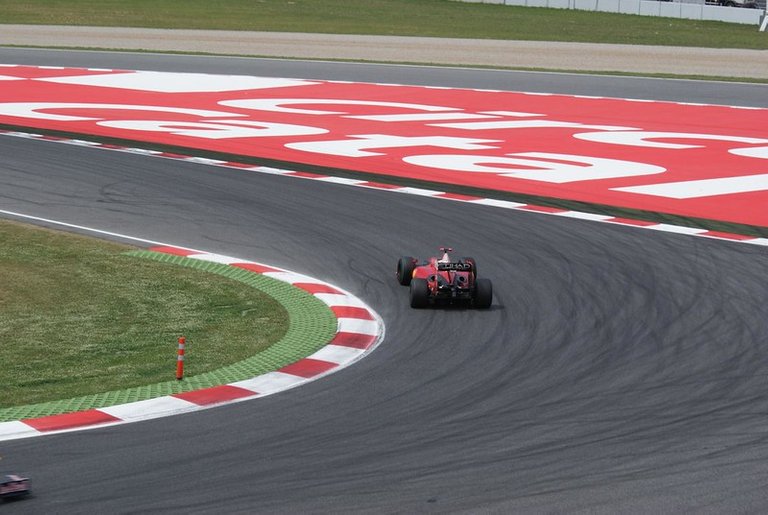
En la imagen de arriba vemos un auto trazando la curva 10 pronunciada, y al fondo se ve la antigua curva redondeada que se utilizaba hace 20 años, atrás de la zona roja. Hoy en día, para incrementar los adelantamientos y por motivos de seguridad, se ha optado por una "solución intermedia", trasladando esta antigua curva redondeada más lejos de las barreras. Las categorías de la Fórmula 1 y la Moto GP quedaron ambas satisfechas con esta solución. Esto se ve en la imagen de abajo:
In the image above we see a car driving through the sharp turn 10, and in the background we can see the old rounded curve that was used 20 years ago, behind the red zone. Today, to increase overtaking and for safety reasons, an "intermediate solution" has been chosen, moving this old rounded curve further away from the barriers. F1 and Moto GP are both satisfied. This is shown in the image below:

De esta manera, se espera que se de una mayor cantidad de adelantamientos en esta zona, además de entrar a la curva sin pisar el freno tan a fondo. La nueva escapatoria quedaría muy en línea con circuitos modernos: varios metros de asfalto y luego grava. Me parece que podríamos ver en carrera peleas muy interesantes en esta zona, y adelantamientos quizás no en la misma curva 10 sino maniobras para adelantar en las siguientes curvas.
In this way, it is expected that there will be a greater amount of overtaking in this area, in addition to entering the corner without pressing the brakes so hard. The new breakaway would be very much in line with modern circuits: asphalt and then gravel. It seems to me that we could see very interesting fights in this area in the race, and overtaking perhaps not in turn 10 itself, but overtaking maneuvers in the following corners.

En la imagen de arriba el trazado a utilizarse para el Gran Premio de España este domingo.
Esta pista posee sectores curvos de alta velocidad, especialmente los sectores 1 y 2, es decir, hasta la curva 9. Las curvas 10, 11, 12 y 14 también contribuyen a darle al circuito características que lo hacen ser un circuito clásico. Esto es favorable a una alta carga aerodinámica, que además de ayudar a transitar el último sector trabado, debe ser equilibrada con la largas rectas donde se requiere la máxima velocidad punta.
Recordemos que la carga aerodinámica ayuda a incrementar la velocidad en curva en declive de la velocidad punta en rectas. Puedes visitar la siguiente publicación para entender un poco la aerodinámica: Ilustrando la F1: aerodinámica básica
In the image above the track to be used for the Spanish Grand Prix this Sunday.
This track has high speed curved sectors, especially sectors 1 and 2, that is, up to turn 9. Turns 10, 11, 12 and 14 also contribute to give the circuit characteristics that make it a classic circuit. This is favorable to a high downforce, which, in addition to helping to negotiate the last tight sector, must be balanced with the long straights where maximum top speed is required.
Let's remember that downforce helps to increase cornering speed in decline of the top speed on the straights. You can visit the following publication to understand a little about aerodynamics: Illustrating F1: basic aerodynamics.

La presencia de curvas de gran radio hace que sea un circuito rápido y fluido, a excepción del último sector que ha sido muy trabado desde que se modificó en el año 2004. A pesar de esto, adelantar no es tan fácil. No existen tantas líneas de carrera diferentes como sí podríamos ver en el circuito de Portugal del fin de semana anterior, cuya pista es más ancha. Las frenadas más fuertes se dan luego de las dos rectas largas y en la curva 5, sitios ideales para adelantar mediante rebufo, aunque podríamos ver adelantamientos en otras zonas.
The presence of large radius curves makes it a fast and fluid circuit, except for the last sector which has been very tight since it was modified in 2004. Despite this, overtaking is not so easy. There are not as many different racing lines as we could see in the previous weekend's Portugal circuit, whose track is wider. The hardest braking is after the two long straights and in turn 5, ideal places to overtake by overtaking, although we could see overtaking in other areas.
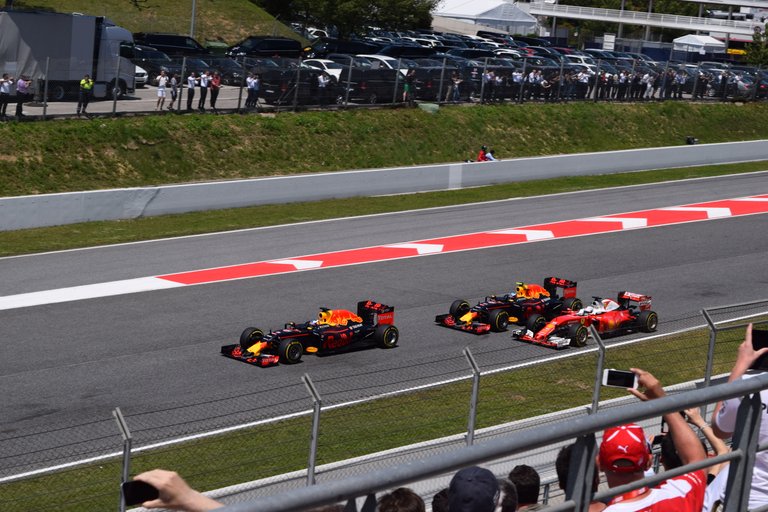
La tendencia en la Fórmula 1 actual parece ser la de regresar a los circuitos redondeados y fluidos. No solamente lo vimos en la temporada 2020 añadiendo los circuitos de Algarve y Mugello, sino también en la modificación reciente al circuito de Albert Park en Australia y en el nuevo circuito de Jeddah en Arabia Saudi, el cual a pesar de ser urbano apenas tiene alguna curva cerrada. Esperemos que esta modificación al circuito de Barcelona-Catalunya deje a los fanáticos satisfechos también en materia de espectáculo.
The trend in Formula 1 today seems to be to return to rounded and fluid circuits. Not only did we see it in the 2020 season by adding the Algarve and Mugello circuits, but also in the recent modification to the Albert Park circuit in Australia and in the new Jeddah circuit in Saudi Arabia, which despite being urban has hardly any sharp turns. I hope that this modification to the Barcelona-Catalunya circuit will leave the fans satisfied as well.
Aprovecho para dejar mi predicción para el podio del Gran Premio de España 2021:
- Hamilton
- Verstappen
- Pérez
¿Cuál es la tuya?
I take this opportunity to leave my prediction for the podium of the Spanish Grand Prix 2021:
1. Hamilton
2. Verstappen
3. Perez
What is yours?
Deja tu comentario o comparte (reblog) si te ha parecido interesante esta publicación.
Leave a comment or share (reblog) if you found this post interesting.
Translated to English language with the help of DeepL.com
| ¡Gracias por visitar! — Deja tu comentario 🚥🏆  |
#POSH
https://twitter.com/acontcivil/status/1390446936281468929?s=19
Tremendo post
Excelente Post muy educativo y entretenido 👍
5 years this has been happening to me, it started here, around people that are still here. Homeland security has done nothing at all, they are not here to protect us. Dont we pay them to stop shit like this? The NSA, CIA, FBI, Police and our Government has done nothing. Just like they did with the Havana Syndrome, nothing. Patriot Act my ass. The American government is completely incompetent. The NSA should be taken over by the military and contained Immediately for investigation. I bet we can get to the sources of V2K and RNM then. https://peakd.com/gangstalking/@acousticpulses/electronic-terrorism-and-gaslighting--if-you-downvote-this-post-you-are-part-of-the-problem